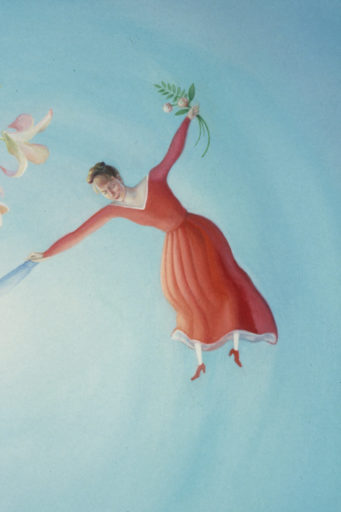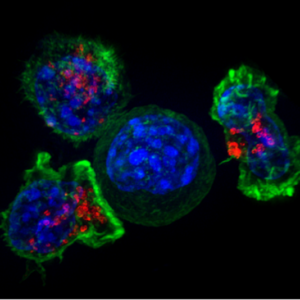There was the burgundy glove: a tiny knit handprint, one of those Dollar Store gloves made to stretch and cinch like a cartoon spring. It roamed the house, appearing on the coffee table or the living room floor, or sometimes on Daniel’s hand. He was wearing it the night he perched on the edge of his dad’s bed and said to me: “I gave my mom these gloves when she was going up to New York to the hospital, and now my hands are the same size as hers.” He held out his twelve-year-old boy’s palm like a bread-and-butter plate and appraised it practically—imagining, I imagine, his mother’s hand in the glove, his mother’s hand in his.
This was in our time of Basement Quarantine. Coronavirus lockdowns hit while my widower fiancé’s half-remodeled house was a hopeful shambles, so five of his eight children holed up in the basement and the nearly-finished second floor, while a troupe of “essential business” construction workers arrived daily to rebuild the gutted ground level. I was down the street, house-sitting for friends who found themselves stranded on vacation and allowed me to stay indefinitely, with daily exits to check in on the sequestered kids.
And so the mise en scéne was set for our odd pandemic drama: an early merge of households, a sudden escalation from visits to shared domestic life—and an immersion in the home that holds the memory of the children’s mother.
Most of what I’d read about modern step-families assumed co-parenting after divorce and remarriage, with at least four adults scrambling for a child’s affection and obedience. But the skein of language reveals that death was once the enduring norm for a child and parent’s untimely parting. “Step” springs from an Old English word for “bereaved,” and “stepchild” was once a neuter term for a child orphaned by a parent’s death. A stepchild only became a “stepdaughter” or “stepson” when a surviving parent married again, with the clinging prefix assuming a child would always be known by his or her loss.
All of the cobbled advice on etymologically consonant step-parenting agreed: let the bereaved child grieve. Go slowly; enter their lives at their pace. Hope to eventually become a friend or a maternal presence, but not a parent. With this in mind, I carted bags of books with me from my home to my pandemic outpost—short stories, poetry, political philosophy I was sure I’d get to in the panicky hush of early lockdown.
At first, this worked: I managed to wedge two novels and a short story collection around brief midday visits and evening dinners in the basement, all of us crouched around the coffee table while a late-staying crew sawed and drilled on the floor above. Then my fiancé asked if I would be willing to homeschool Daniel and keep the older kids on a regular schedule, and I said yes.
And just as quickly, I stopped reading—or more accurately, I stopped finishing the books I started. I suddenly found myself at the house every morning, often before the kids woke, totally breaking the letter and spirit of the “go slowly” law. Cajoling them to wake, bathe, dress, eat, sit, read, sometimes we had fun and sometimes I felt, as I confessed to a friend, like a pioneer shrew, homesteading in a dugout with my slightly embittered party. At night, spent and sometimes brooding over the mistakes of the day, I could barely pick up a book.
But when I stopped reading, I began remembering: the battle chant of Psalm 118 , Edna St. Vincent Millay’s tired and merry “Recuerdo”, the longing compass of Donne’s “Valediction Forbidding Mourning”—scriptures and poems memorized years ago, now welling up. They coursed through my mind as we made it through each day, brushing up against the material and immaterial stuff of grief: their mother’s sweet seventh grade school picture, enshrined in a pleather wallet; the hulking box of her sealed wedding gown; her voice, deeper than I expected, captured in old home videos that Daniel and his sister played again and again, laughing and happy as they called me to come watch with them.
Sitting before the computer screen, I saw their mother’s living face for the first time. I watched them watch her, their faces even and open as adorers at a monstrance. I thought about the co-parenting books: almost forceful on the difficulties of loving a child with an army of living, often acrimonious parents. And I recalled families where the deceased wife lingered like a jealous kitchen god. But this and the other mementos seemed less like pinches of incense and more like gestures of longing, natural traces of life. Their mother was alive, on the screen and in her mystical life, and there was no acrimony, no competition. I watched them watch her, leaning in to close the gap, swerving back to her as to Donne’s set compass point, her firmness steadying their arc.
Image: “Me in Mrs. Chagall’s Dress” (Love’s Lyric, 2001) by Laura Lasworth
Laura Bramon is a writer and international development practitioner based in Washington, DC. Her writing has appeared in The Best Creative Non-Fiction, Vol. 3 (W.W. Norton), Image, University of Notre Dame’s Church Life Journal, First Thingsonline, Humanum Review, and other outlets.





